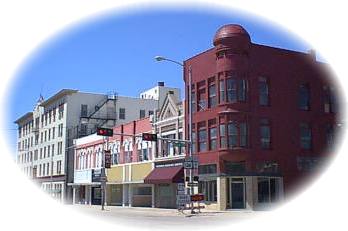
The Gage County Historical Society Museum collections emphasize five major themes and number about 11,000 with over 4,000 photographic images. Photos are used extensively in exhibits, giving visitors a true vision of the county's history.
Famous Gage County residents include actor, Robert Taylor. Spangler Arlington Brugh. "Arly" moved to the city with his parents in 1917 at age six. He enjoyed oratory and debate at Beatrice High School, graduating in 1929, and attended Doane College at Crete, then Pomona College in California, where he was "discovered." In 1934 he signed a movie contract under the name "Robert Taylor." In his 58-year lifespan he made over 89 major motion pictures for MGM and starred on Death Valley Days and The Detectives on TV.
Harold Lloyd, who pioneered early "talkies" spent formative years in Beatrice and had his first stage appearance in the community.
National Football Hall of Fame and College Football Hall of Fame recipient, Berlin Guy Chamberlin, was born and raised in Gage County.
The Pure Food and Drug Act, which still helps protect consumers today, was first introduced by Senator Algernon Paddock of Beatrice.
Women such as Clara Colby, who published the nation's longest running women's suffrage newspaper were an important part of the community.
Believed to be the oldest continuous manufacturing company in the state, F.D. Kees grew from a gun and lock repair shop begun in 1874. Hardware items include the No.308 Barn Door Latch, which not only held a door closed, but also held it open. After electrical items and a line of lawn and garden equipment were added, it became a subsidiary of Snapper Power Equipment Division of Fuqua Industries.
In 1878, C.B. Dempster started Dempster Miller Manufacturing, a retail pump and windmill store in downtown Beatrice.
Dempster began manufacturing its own windmills and pumps in 1885. Later, they began the manufacture of Dempster gasoline
engines. Their windmills are still being manufactured today. A display of Dempsters can be seen at the Gage County Museum. That little shop developed into a large factory that carries the name and fame of Beatrice all over the world.
A creamery was established by G.E. Haskel and W. W. Bosworth in 1894 to buy poultry, butter, and eggs. By 1910 the company operated nine creameries and three ice plants. Under the trademark "Meadow Gold," its ice cream became a national commodity. The headquarters moved to Chicago in 1913, with the name changed to "Beatrice Foods" in 1946. The growth of convenience foods following World War II led to specialty snack items. La Choy joined "the family" in 1943, and a grocery division was organized in 1957. The company expanded its horizons to international levels in the 1960s, with Samsonite luggage joining in 1973. The story of Beatrice Foods is a chronicle of progressive growth in the American free enterprise system. Now part of Bordens Inc., only the history of this small partnership and nostalgia remain of the 92-year relationship with our town.
The Luebben Baler was the first patented round hay baler ever made and is the forerunner of the balers that you often see making large round hay bales.
T. E. Adams started making steel tanks in 1911, soon adding such items as road culverts, grain bins, and irrigation equipment. Producing ordinance material for the war effort, the BST Company switched to making aluminum beer barrels in 1945, which were sold nationwide. In the 1950s the company entered the bulk material field, employing over 300, today known as Hoover Group, Inc.
William Morton, after designing and building his own display case for candy, founded "Store Kraft Manufacturing," in the 1920s. It built turret seats and other materials for defense during the war, and developed a complete line of store equipment by the 1960s. With about 400 employees, sales are currently recorded from all 50 states.
The Dole Floral business, started in 1891 with a $1.75 investment by Sophie Dole, now had many greenhouses in mid-western cities.
